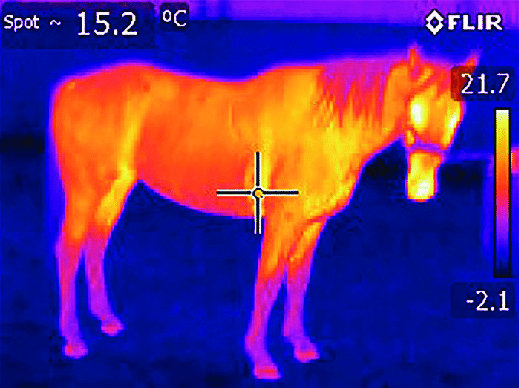Thermal imaging is a type of infrared photography that can be used to detect differences in heat. The camera creates an image based on the temperature of objects in front of it. This allows you to see things that would be otherwise invisible to the naked eye, such as heat loss from a horse’s body.
Thermal imaging can be used for a variety of purposes, such as detecting injuries, finding sore spots, and checking for circulation problems. It can also be used to monitor a horse’s overall health and fitness.
How thermal imaging can help your horse
Thermal imaging can be a valuable tool for monitoring your horse’s health and wellbeing. It can help you to:
- Detect injuries: Thermal imaging can help you to spot injuries that may not be visible to the naked eye.
- Find sore spots: If your horse has a sore spot, the area will likely be warmer than the surrounding tissue. Thermal imaging can help you to find these areas so that you can provide treatment.
- Check for circulation problems: Circulation problems can often be detected through changes in temperature. Thermal imaging can help you to identify these problems so that they can be treated appropriately.
- Monitor overall health and fitness: By tracking changes in your horse’s body temperature over time, thermal imaging can give you valuable insights into their overall health and fitness.
Thermal imaging is a non-invasive way of monitoring your horse’s health and wellbeing. It is safe for both you and your horse, and it can provide valuable information that can help you to keep your horse healthy and happy.
The benefits of using thermal imaging on horses
Thermal imaging can offer a number of benefits for horses and their owners. These benefits include:
- Early detection of injuries: Thermal imaging can help you to detect injuries at an early stage, before they become more serious. This allows you to provide treatment quickly and prevent further damage.
- Improved circulation: by identifying circulation problems, thermal imaging can help you to improve your horse’s overall health and fitness.
- Better overall health: by monitoring your horse’s temperature over time, thermal imaging can give you valuable insights into their overall health and wellbeing.
How to use thermal imaging to detect health problems in horses
If you are concerned about your horse’s health, thermal imaging can be a valuable tool for detecting potential problems. Here are some tips on how to use thermal imaging to detect health problems in horses:
- Check for areas of heat loss: Horses typically lose heat from their extremities, such as their legs and feet. If you see an area of heat loss, it may be a sign of an injury or circulation problem.
- Look for changes in temperature: If you notice a sudden change in your horse’s body temperature, it could be a sign of illness.
- Monitor your horse over time: By tracking changes in your horse’s body temperature over time, you can get valuable insights into their overall health and wellbeing.
Thermal imaging can be a valuable tool for detecting health problems in horses. By monitoring your horse’s body temperature, you can get valuable insights into their overall health and wellbeing.
Tips for keeping your horse healthy and safe with the help of thermal imaging
Thermal imaging can be a valuable tool for keeping your horse healthy and safe. Here are some tips on how to use thermal imaging to keep your horse healthy and safe:
- Check for injuries regularly: Thermal imaging can help you to detect injuries at an early stage, before they become more serious. Regular checks can help you to spot problems quickly and provide treatment before it is too late.
- Monitor your horse’s health over time: By tracking changes in your horse’s body temperature over time, you can get valuable insights into their overall health and wellbeing. This information can help you to identify problems early and take steps to prevent them from becoming worse.
- Keep an eye on their environment: Thermal imaging can also be used to monitor your horse’s environment. By checking the temperature of their stall or pasture, you can make sure that they are not in danger of overheating or becoming too cold.
Thermal imaging can be a valuable tool for keeping your horse healthy and safe. By monitoring your horse’s body temperature, you can get valuable insights into their overall health and wellbeing. This information can help you to identify problems early and take steps to prevent them from becoming worse.
